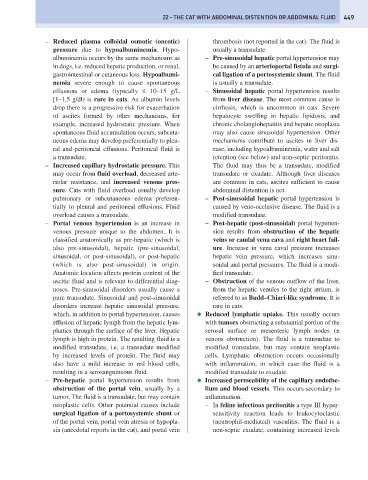Page 457 - Problem-Based Feline Medicine
P. 457
22 – THE CAT WITH ABDOMINAL DISTENTION OR ABDOMINAL FLUID 449
– Reduced plasma colloidal osmotic (oncotic) thrombosis (not reported in the cat). The fluid is
pressure due to hypoalbuminemia. Hypo- usually a transudate.
albuminemia occurs by the same mechanisms as – Pre-sinusoidal hepatic portal hypertension may
in dogs, i.e. reduced hepatic production, or renal, be caused by an arterioportal fistula and surgi-
gastrointestinal or cutaneous loss. Hypoalbumi- cal ligation of a portosystemic shunt. The fluid
nemia severe enough to cause spontaneous is usually a transudate.
effusions or edema (typically ≤ 10–15 g/L – Sinusoidal hepatic portal hypertension results
[1–1.5 g/dl) is rare in cats. As albumin levels from liver disease. The most common cause is
drop there is a progressive risk for exacerbation cirrhosis, which is uncommon in cats. Severe
of ascites formed by other mechanisms, for hepatocyte swelling in hepatic lipidosis, and
example, increased hydrostatic pressure. When chronic cholangiohepatitis and hepatic neoplasia
spontaneous fluid accumulation occurs, subcuta- may also cause sinusoidal hypertension. Other
neous edema may develop preferentially to pleu- mechanisms contribute to ascites in liver dis-
ral and peritoneal effusions. Peritoneal fluid is ease, including hypoalbuminemia, water and salt
a transudate. retention (see below) and non-septic peritonitis.
– Increased capillary hydrostatic pressure. This The fluid may thus be a transudate, modified
may occur from fluid overload, decreased arte- transudate or exudate. Although liver diseases
riolar resistance, and increased venous pres- are common in cats, ascites sufficient to cause
sure. Cats with fluid overload usually develop abdominal distention is not.
pulmonary or subcutaneous edema preferen- – Post-sinusoidal hepatic portal hypertension is
tially to pleural and peritoneal effusions. Fluid caused by veno-occlusive disease. The fluid is a
overload causes a transudate. modified transudate.
– Portal venous hypertension is an increase in – Post-hepatic (post-sinusoidal) portal hyperten-
venous pressure unique to the abdomen. It is sion results from obstruction of the hepatic
classified anatomically as pre-hepatic (which is veins or caudal vena cava and right heart fail-
also pre-sinusoidal), hepatic (pre-sinusoidal, ure. Increase in vena caval pressure increases
sinusoidal, or post-sinusoidal), or post-hepatic hepatic vein pressure, which increases sinu-
(which is also post-sinusoidal) in origin. soidal and portal pressures. The fluid is a modi-
Anatomic location affects protein content of the fied transudate.
ascitic fluid and is relevant to differential diag- – Obstruction of the venous outflow of the liver,
noses. Pre-sinusoidal disorders usually cause a from the hepatic venules to the right atrium, is
pure transudate. Sinusoidal and post-sinusoidal referred to as Budd–Chiari-like syndrome. It is
disorders increase hepatic sinusoidal pressure, rare in cats.
which, in addition to portal hypertension, causes ● Reduced lymphatic uptake. This usually occurs
effusion of hepatic lymph from the hepatic lym- with tumors obstructing a substantial portion of the
phatics through the surface of the liver. Hepatic serosal surface or mesenteric lymph nodes (±
lymph is high in protein. The resulting fluid is a venous obstruction). The fluid is a transudate to
modified transudate, i.e. a transudate modified modified transudate, but may contain neoplastic
by increased levels of protein. The fluid may cells. Lymphatic obstruction occurs occasionally
also have a mild increase in red blood cells, with inflammation, in which case the fluid is a
resulting in a serosanguineous fluid. modified transudate to exudate.
– Pre-hepatic portal hypertension results from ● Increased permeability of the capillary endothe-
obstruction of the portal vein, usually by a lium and blood vessels. This occurs secondary to
tumor. The fluid is a transudate, but may contain inflammation.
neoplastic cells. Other potential causes include – In feline infectious peritonitis a type III hyper-
surgical ligation of a portosystemic shunt or sensitivity reaction leads to leukocytoclastic
of the portal vein, portal vein atresia or hypopla- (neutrophil-mediated) vasculitis. The fluid is a
sia (anecdotal reports in the cat), and portal vein non-septic exudate, containing increased levels

